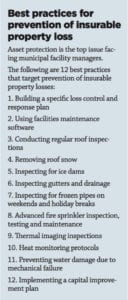Who is a member?
Our members are the local governments of Massachusetts and their elected and appointed leadership.
 As the nonprofit insurance arm of the Massachusetts Municipal Association, MIIA is often asked what factors cause the most insurance risk and loss. At the top of the list is property risk, which continues to present significant losses to municipalities, even though many of the risk factors are known and can be mitigated or prevented.
As the nonprofit insurance arm of the Massachusetts Municipal Association, MIIA is often asked what factors cause the most insurance risk and loss. At the top of the list is property risk, which continues to present significant losses to municipalities, even though many of the risk factors are known and can be mitigated or prevented.
When it comes to property risk, the following three major factors contribute to loss:
1. Resource Allocation. When cities and towns do not allocate enough resources for capital improvement and facilities management, including preventative maintenance, they are kicking the proverbial can down the road. Without an annual capital improvement plan and budget, cities and towns are neglecting their most important asset: capital buildings.
It is important to note that minimizing property loss is not solely a function of available capital or technology. The human element – training, procedures and allocation of people – allows communities to reduce their property risk without spending a lot of money. Instituting formal facility management programs and protocols can go a long way to countering losses.
2. Extreme Weather Events. Record freezing temperatures, a barrage of Nor’easters, torrential downpours and other extreme weather events cause a heavy toll in property damage. Sudden frigid temperatures combined with high winds have resulted in extensive and expensive water damage from burst pipes in municipal buildings throughout the state.
3. Aging Infrastructure. According to a 2018 study by CNBC, one of the things holding Massachusetts back from a true top-state status is its infrastructure. “All too often, the 230-year-old state shows its age, particularly when it comes to water utilities,” the study reported. The state was given an infrastructure grade of D+.
Minimizing losses
Cities and towns are wise to invest in proactive maintenance. It may seem prudent to allocate money to more pressing needs, but the result can be a budget-busting emergency expense down the road.
It’s worth noting that cost is not the only impact of property loss.
“When any town building goes down,” says Foxborough Town Manager William Keegan Jr., “it can mean we are not able to provide important services and resources to our residents and employees.”
A case in point: The water line to a sink to a school lab fails over the weekend, allowing water to flow uninterrupted through the science wing for two days. When school reopens, there is water throughout the school, soaking into walls, floor-mounted labs and electrical outlets, and damaging flooring. The water has to be extracted and the school needs to be thoroughly dried before any repair work can even begin.
A combination of the following best practices, maintenance procedures, and technology might have prevented or mitigated this loss.
• Routine Mechanical Inspections might have found evidence of rust, corrosion or improper threading at the site of the water connection.
• A Preventive Maintenance Program that called for periodic replacement of mechanical plumbing connections might have prevented the loss before the connection began to degrade and fail.
• Water Sensor Technology would not have prevented the loss, but strategically located floor water sensors would have detected water migration on the floor, allowing for a prompt response resulting in less damage. Many towns do not detect problems when they occur because monitoring technology has not been installed, and it can be days (such as over a long holiday weekend or vacation week) before a problem is discovered. By then, the damage can be 100-fold worse.
Future of facility management
Adopting sophisticated monitoring technology, both hardware and software, may seem like a daunting challenge for today’s fiscally constrained cities and towns. But many technology solutions are cost-effective and readily available.
For example, infrared cameras offer high-resolution thermal imaging that can find hidden electrical faults, mechanical issues and sources of energy loss. Professional-quality, high resolution thermal cameras range from $300 to $3,000 or more, and many offer predictive maintenance capabilities and Wi-Fi connectivity.
Cloud-based software solutions can bring automation and data-driven insights to schools and municipal buildings with limited resources. Data integration and predictive analytics can help facility managers know when something is going to break before it happens.
Today’s facility management requires a dedicated and well-trained staff. With an increasing amount of automation and technology being deployed, municipalities are centralizing their facility operations and maintenance function. Expert technicians can be deployed across departments for increasingly sophisticated service and repair work.
Many cities and towns across the state have made great progress in developing and activating comprehensive facility management programs that have resulted in cost savings and a reduction in property claims. And these cities and towns are willing to share what they have learned and how they are implementing their programs. In fact, with tight budgets and expanded municipal responsibilities, interest in resource- and staff-sharing across jurisdictional boundaries is likely to continue to grow.
“The most responsible thing we can do is to maintain our facilities to prolong their longevity,” Keegan says, “while providing a good environment for employees, students and the community at large.”
A proactive approach to property risk will reduce the occurrence and severity of property damage while helping to bridge municipal resource and budget shortfalls.
Stan Corcoran is the Executive Vice President of MIIA.